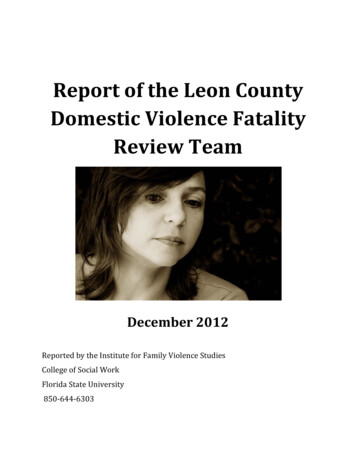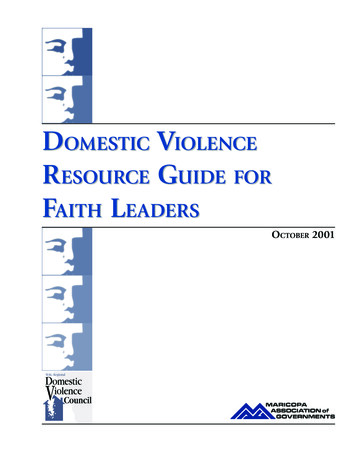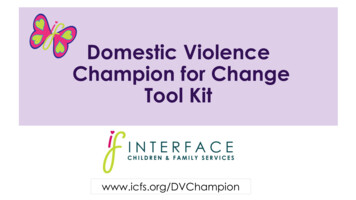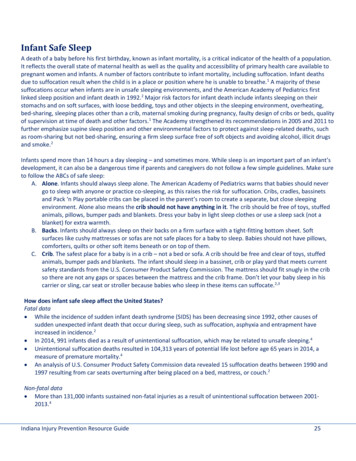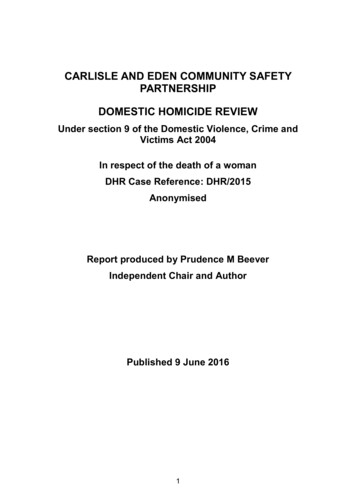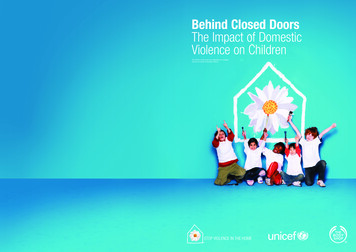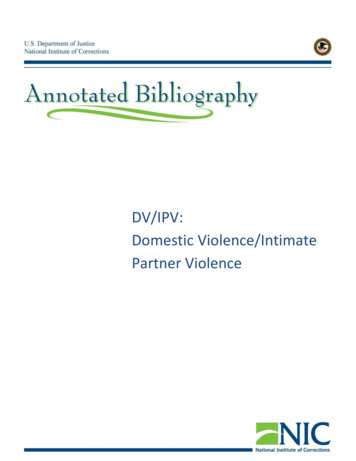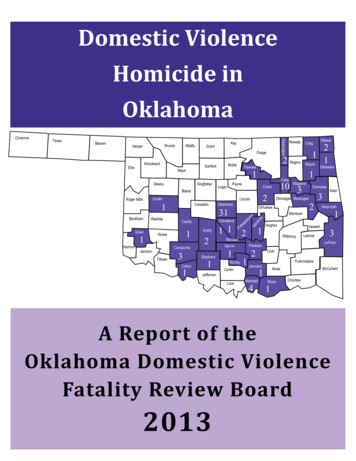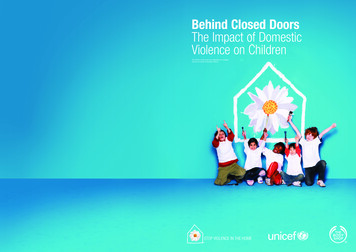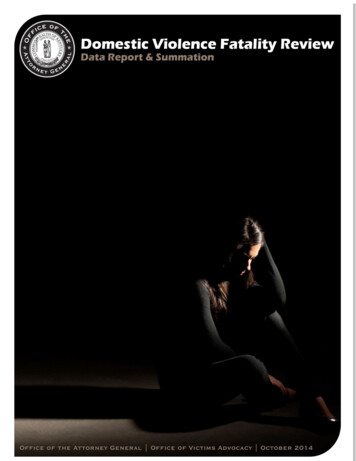
Transcription
DOMESTIC VIOLENCE FATALITY REVIEWDATA REPORT AND SUMMATIONOFFICE OF THE ATTORNEY GENERALOFFICE OF VICTIMS ADVOCACYOCTOBER 2014
Table of ContentsExecutive Summary, Attorney General Jack Conway . . . . . . . . . . . . . . . . . . . . . . . . . . . . . . . . . . . . . . . . . . .1HISTORY OF DOMESTIC VIOLENCE LAWS AND SERVICES IN KENTUCKY . . . . . . . . . . . . . . . . . . . . . . . . . . . . 2COMMENCEMENT AND SCOPE OF THE “SUMMIT” . . . . . . . . . . . . . . . . . . . . . . . . . . . . . . . . . . . . . . . . . . . . .4Domestic Violence Fatality Review Efforts in Kentucky at the Time of the Summit . . . . . . . . . . . . 6Louisville and Jefferson County . . . . . . . . . . . . . . . . . . . . . . . . . . . . . . . . . . . . . . . . . . . . . . . .6Lexington and Fayette County . . . . . . . . . . . . . . . . . . . . . . . . . . . . . . . . . . . . . . . . . . . . . . . .7METHODOLOGY . . . . . . . . . . . . . . . . . . . . . . . . . . . . . . . . . . . . . . . . . . . . . . . . . . . . . . . . . . . . . . . . . . . . . . . . . 9A STATE PLAN. . . . . . . . . . . . . . . . . . . . . . . . . . . . . . . . . . . . . . . . . . . . . . . . . . . . . . . . . . . . . . . . . . . 10Objectives of Fatality Review. . . . . . . . . . . . . . . . . . . . . . . . . . . . . . . . . . . . . . . . . . . . . . . . 10Work and Results of the Summit Committees. . . . . . . . . . . . . . . . . . . . . . . . . . . . . . . . . . 11LEGISLATIVE UPDATES 2012-2013. . . . . . . . . . . . . . . . . . . . . . . . . . . . . . . . . . . . . . . . . . . . . . . . . . . . . . . . . . 12LIMITATIONS AND RECOMMENDATIONS . . . . . . . . . . . . . . . . . . . . . . . . . . . . . . . . . . . . . . . . . . . . . . . . . . . 16CREATING A FATALITY REVIEW TEAM IN YOUR COUNTY:A Guide to Development of Policies and Model Policies . . . . . . . . . . . . . . . . . . . . . . . . . . . . . . . . . . . . . . . . 17“KEY DECISIONS TO GETTING STARTED” . . . . . . . . . . . . . . . . . . . . . . . . . . . . . . . . . . . . . . . . . . . . . . . . . . . . 18Appendix. . . . . . . . . . . . . . . . . . . . . . . . . . . . . . . . . . . . . . . . . . . . . . . . . . . . . . . . . . . . . . . . . . . . . . . . . . .25MODEL PROTOCOL FOR DOMESTIC VIOLENCE FATALITY REVIEW TEAM . . . . . . . . . . . . . . . . . . . . . . . . . . A1MODEL SIGN-IN / CONFIDENTIALITY STATEMENT. . . . . . . . . . . . . . . . . . . . . . . . . . . . . . . . . . . . . . . . . . . . . A2Domestic Violence Fatality – Special Report – Kentucky 2010 Homicides. . . . . . . . . . . . . . . . . . . . . A3Prepared and compiled byOffice of the Attorney GeneralOffice of Victims AdvocacyGerina Whethers, Executive DirectorMitchel T. Denham, Assistant Deputy Attorney General
Jack ConwayOffice of the Attorney GeneralAs we observe October as Domestic Violence Awareness Month, I am reminded of this horrific epidemicand its effects. In the Commonwealth alone, one in three women will be a domestic violence victim inher lifetime (KCHFS, 2006). While the statistics are staggering, my primary concern is the protection ofour victims and their families and the prevention of domestic violence.That’s why I convened Kentucky’s first statewide Summit on Domestic Violence Fatalities. This summitbrought together experts from across the Commonwealth forming the Statewide Domestic ViolenceFatality Review Committee. The goals of the summit were multifaceted including: development of aplan for collection and analysis of domestic violence fatalities in the Commonwealth, development oflocal domestic violence fatality review teams, and development of model policies and procedures toguide the work of the local teams.The Statewide Domestic Violence Fatality Review Committee soon began to realize that Kentucky didnot have the data needed to provide a clear picture of the extent and nature of domestic violencefatalities in the Commonwealth. Believing that such data was critical to guiding the future work of thecommittee, the members set as their first priority the development of a data collection tool to collectinformation about the domestic violence related deaths that occurred in Kentucky in 2010.The collection of this data resulted in the publication of this Domestic Violence Fatality Special Report. Iam confident that the information contained in this report will not only provide valuable information toguide the future work of the committee, but will also help advance our mission of preventing futuredomestic violence fatalities and preserving the safety of our victims throughout the Commonwealth.Finally, I want to thank the members of the committee, especially Dr. TK Logan, for volunteering theirtime, and for their dedication to this initiative. Without their assistance this report would not have beenpossible.Sincerely,Jack ConwayKentucky Attorney General
HISTORY OF DOMESTIC VIOLENCELAWS AND SERVICES IN KENTUCKY
Domestic Violence Fatality Review has the objectives of preventing domestic violence fatalities,preserving the safety of victims, holding accountable the perpetrators of domestic violence andcreating collaborative efforts with multiple agencies and organizations. According to theKentucky Coalition Against Domestic Violence, “KCADV,” “community awareness of thepervasiveness and severity of domestic violence in Kentucky heightened in the late 1970's. TheYWCA in Louisville opened Kentucky's first spouse abuse shelter in 1977. By 1980 there weresix shelter programs serving battered women and their children in Kentucky.1” KCADV wasfounded in 1981 and by 1985 had reached its goals of having a domestic violence program ineach of the Commonwealth’s Area Development Districts and a stable funding stream.With services available across the Commonwealth, KCADV and other interested agencies,organizations and professionals began to advocate for changes in state laws. The focus of thesechanges was on increasing protection for and providing services and assistance to victims ofdomestic violence. Moreover, there was a need for improving the criminal justice system’sresponse to domestic violence including holding offenders accountable.As a response, formal and informal multidisciplinary efforts for improving laws in the area ofdomestic violence soon followed. The collaborative efforts and initiatives from AttorneyGeneral Conway’s Task Force on Domestic Violence Crime, Kentucky’s Legislative Task Force onDomestic Violence, and the Governor’s Council on Domestic Violence and Sexual Assault led tomany positive legislative changes. In 2002, these changes included the passage of legislation bythe General Assembly specifically authorizing the creation of Domestic Violence Fatality ReviewTeams in local communities.2Although much work had been done over the past four decades to address domestic violence,still more work remained. To continue and to further advance the idea and importance ofdomestic violence fatality review, Attorney General Conway convened Kentucky’s firststatewide Summit on Domestic Violence Fatalities in August of 2011.12http://www.kdva.org/about/history.html.KRS 403.750.3
COMMENCEMENT AND SCOPEOF THE “SUMMIT”
The Summit of 2011 brought the expertise of professionals from across the Commonwealth inthe areas of domestic violence, domestic violence fatality review and data collection andanalysis. The Summit invitees were: Lee Alcott, Executive Director, Barren River Area SafeSpace, Inc.; Kim Allen, Louisville Metro Government; Honorable Jerry Bowles, Family CourtJudge, Jefferson County; Secretary J. Michael Brown, Kentucky Justice and Public SafetyCabinet; Hon. Carol Cobb, Assistant Commonwealth Attorney, Jefferson County; Hon.Christopher Cohron, Commonwealth’s Attorney, Warren County; Dr. Tracey Corey, ChiefMedical Examiner; Sherry Currens,Executive Director, Kentucky Domestic ViolenceAssociation; Teri Faragher, Director, Lexington-Fayette County Domestic Violence PreventionBoard; Jim Grace, Assistant Director, Cabinet for Health and Family Services, Department forCommunity Based Services, Division of Protection and Permanency (retired); Carol Jordan,Director, University of Kentucky Office for Policy Studies on Violence Against Women; Dr. TKLogan, Professor, Department of Behavioral Science, College of Medicine and Center on Drugand Alcohol Research, University of Kentucky; Lt. Carolyn Nunn, Commander, Special VictimsUnit, Louisville Metro Police Department; Marcia Roth, Executive Director, Mary Byron Project;Dr. Sabrina Walsh, Assistant Professor, Department of Epidemiology, College of Public Health,University of Kentucky; Commissioner Pat Wilson, Cabinet for Health and Family Services,Department for Community Based Services (retired);Hon. Kathy Phillips, AssistantCommonwealth’s Attorney, Fayette County; Hon. Michelle Snodgrass, Commonwealth’sAttorney, Campbell County; Dr. Barbara Weakley Jones, Coroner, Jefferson County; andHonorable Jo Ann Wise, Family Court Judge (retired).Attorney General Conway set forth goals of the Summit to discuss the establishment of astatewide domestic violence fatality review program in the Commonwealth, development of aplan for collection and analysis of domestic violence fatalities, development of local domesticviolence fatality review teams, and the development of model policies and procedures to guidethe work of the local teams.To reach the long-term goals of the Summit, the participants divided into two committees: theresearch and data collection committee, and the protocol development committee.5
DOMESTIC VIOLENCE FATALITY REVIEW EFFORTS IN KENTUCKY AT TIME OF THE SUMMITIn 2011, Kentucky statutes did not specifically permit or prohibit statewide fatality reviewteams. KRS 403.705 does, however, specifically authorize the establishment in any jurisdictionor group of counties local domestic violence coordinating councils. KRS 403.705(5) furtherprovides that “local domestic violence coordinating councils may, if authorized by the localcoroner or a medical examiner, create a domestic violence fatality review team, the purpose ofwhich shall be to prevent future deaths and injuries related to domestic violence.”Although KRS 403.705 was enacted in 2000, only Louisville/Jefferson County andLexington/Fayette County had established teams at the time the Summit was held.Louisville and Jefferson CountyIn January 1996, the Jefferson County Fiscal Court enacted Ordinance No. 1, Series 1996creating the Jefferson County Domestic Violence Prevention Coordinating Council. The Councilwas formed based on the prevalent need to address domestic violence and its effects in thecommunity. To assist the Council with its work, the Mortality Review Committee (renamed theFatality Review Committee in 2004) was created. In December 1996, a multi-agency,multidisciplinary group convened and reported on data stemming from a high profile domesticviolence fatality that occurred in the city. Each member agency was required to sign aconfidentiality agreement on behalf of the agency and its employees upon joining the team andeach team member signed a confidentiality agreement at the beginning of each meeting. Allteam files and notes were kept in a locked location at the Criminal Justice Commission.The purpose of the Louisville team is to identify areas and means by which to increase andenhance coordinated agency and community responses to domestic violence through asystems-review approach by conducting multidisciplinary and multi-agency examinations ofdomestic violence fatalities. The Louisville team identifies areas and means by which toincrease and enhance coordinated agency and community responses to domestic violencethrough a systems-review multidisciplinary approach.Its goals are focused on prevention, knowledge, accountability and systems improvement.The team adopted a “no blame or shame” philosophy. Individuals are not blamed or singledout, rather processes, systems and policies are reviewed and recommendations forimprovements are made when necessary.The Louisville team reviews both open and closed cases involving adults 18 years of age or olderwhere either party resides within Louisville Metro or if the incident occurs in Louisville Metroregardless of the residence of the parties. Cases are reviewed within the fiscal year duringwhich they occur and are identified for potential review through agency request for a review,Coroner or Medical Examiner reports, media reports or obituaries. Potential cases arereviewed by team Chairs to determine if the criteria for review are met and if so the cases areadded to the agenda for the next meeting. Prior to a meeting team member agencies are given6
a list of the cases to be reviewed and are responsible for acquiring and bringing to the meetingall pertinent records.Today, Louisville has created the Lethality Assessment Program “LAP” which focuses onrelationship history, dynamics and lethality and it engages victims with social services in thecommunity that can attend to the diverse needs of victims. The LAP provides victims at thescene of a police involved intimate partner violence incident with education about their level ofrisk for lethal and near lethal intimate partner violence if they remain in the abusiverelationship. The LAP also provides information about and referrals to community resourceswhich can provide assistance. The LAP involves a 2-step process. First, a police officerresponding to the scene of a domestic violence incident utilizes a brief 11-item risk assessmentto identify victims at high risk of homicide. Second, women that screen in as “high risk,” basedon the Lethality Screen, are immediately put in telephone contact with a social service providerwho provides safety planning and referral for services.Lexington and Fayette CountyThe Lexington/Fayette County team also adopted a protocol and began reviewing cases in1996. Team members included the following: the Coroner’s Office, Bluegrass Domestic ViolenceProgram, Bluegrass Rape Crisis Center, the Department for Community Based Services, aDistrict Court Judge, Domestic Violence Prevention Board, Commonwealth’s Attorney, CountyAttorney Victim Advocate, County Attorney, Fayette Public Schools, Fayette County Sheriff,Probation/Parole, Lexington-Fayette Urban County Government and other agencyrepresentatives with a legitimate interest in a case.The team reviewed approximately 10 cases until review was suspended at or around 2002 toawait an anticipated statewide plan. Data collection played a big part of the new state plan andthe Lexington team wanted its data to be consistent. When it became clear that a statewideplan would not be announced, the Lexington team once again began reviewing cases in 2007.The team reviewed approximately 10 additional cases between 2007 and the Summit in 2011.According to the guidelines in effect in 2011, the purpose of the Fayette County DomesticViolence Fatality/Near Fatality Review Team is to refine, improve and coordinate thecommunity’s response to domestic violence crime in order to prevent future injuries andfatalities. Through case review the team identifies gaps in services; recognizes patterns thatmay indicate escalating violence and the threat of death; assesses the current responses of thecriminal justice and social services systems to victims of domestic violence; supportscooperation and communication among agencies; and formulates findings andrecommendations aimed at improving the community’s system of prevention and interventionservices. Like the Louisville team, the purpose of this team is also not to fix blame but toanalyze and refine systems response to the problem. This team, too, considers confidentiality acritical issue. All team members must sign a confidentiality agreement before each meeting.The Fayette County team reviews fatality and near fatality cases including homicide or suicideof any family member or intimate partner that are domestic violence related and in which the7
domestic violence occurred primarily in Fayette County. Any member of the team may requestthat a case be reviewed. Cases are not reviewed until the law enforcement agency hascompleted its investigation or, if criminal charges are placed, until the prosecution has beencompleted as far as the trial level. The team Chair with assistance from the Domestic ViolencePrevention Board will designate a meeting time and location and notify members of the case(s)to be reviewed. Involved agencies and organizations will bring all records and informationrelevant to the cases(s) to the meeting.In addition to reviewing cases involving domestic violence fatalities, Lexington-Fayette Countyalso has a high risk domestic violence response or “Red Flag” team. The purpose of this team isto facilitate a coordinated and collaborative community effort to identify and address high riskdomestic violence cases. The team meets every other week with the goal of streamliningcommunication among agencies and determining appropriate interventions that increaseoffender accountability and reduce the risk of harm to victims. Referrals are made through anon-line referral system located on the Commonwealth’s Attorney’s website. Once a referral ismade, the team discusses the case at its next meeting and decides as a group whether or not itis appropriate for “Red Flag.” One of the determining factors as to whether a case is classifiedas a “Red Flag” case is whether or not the team can identify action steps that can be taken toreduce risk. Team review does not relieve individual members of the responsibility to takeaction, as they always have, through their regular job responsibilities. Team approval is notrequired for members to do what they would otherwise normally do. However, as a team theycan often piece together a more comprehensive plan for risk reduction than they could think ofor implement individually.8
METHODOLOGY
A STATE PLANIn 2002 a statewide fatality review plan was envisioned. Ms. Carol Jordan, (then ExecutiveDirector of the Governor’s Office of Child Abuse and Domestic Violence Services), Mr. Jim Grace(then a member of Ms. Jordan’s staff), Ms. Teri Faragher (Executive Director of the LexingtonFayette County Domestic Violence Prevention Board), Dr. TK Logan (Professor, University ofKentucky) and Hon. Jerry Bowles (Judge, Jefferson Family Court) attended a nationalconference to learn about the various types of domestic violence fatality review initiativestaking place around the country so that they could better assist developing a statewide plan forKentucky.Thereafter, a state domestic violence fatality review council would be established with a twofold purpose. First, the council would be available along with staff to assist in developing localteams, provide technical assistance, provide a link between teams and assist them in sharingexpertise/serving as resources for each other, and develop model protocols and tools for use bylocal teams. Second, a state domestic violence fatality review team would be established.Local communities wishing to have a more extensive review (such as one involving interviews offamily members) could invite the state team to review a particular case.In 2010, the National Domestic Violence Review Initiative, funded by the Office on ViolenceAgainst Women and the United States Department of Justice and located at Northern ArizonaUniversity, published a state by state matrix of then-existing domestic violence fatality reviewteams. Based upon the information contained in that matrix and obtained through additionalresearch by OAG staff, it was determined that in 2011, 14 states had statewide domesticviolence fatality review teams.3 All except Kansas, New Hampshire and Utah were establishedby legislation. Through legislation or other means, 18 states authorize local or regional teams.The authorizing legislation in Michigan specifically permits a state team or local teams but astate team had not been created. Similar legislation allowing for either state or local teams inAlabama did not pass. Additionally, a similar process is used in that Connecticut calledinvestigative reports. Finally, 18 states appeared to not have domestic violence fatality reviewteams at any level - local, regional or state.OBJECTIVES OF FATALITY REVIEWDomestic Violence Fatality Review typically has the objectives of preventing domestic violencefatalities in the future, preserving the safety of battered women and holding accountable boththe perpetrators of domestic violence and the multiple agencies and organizations that comeinto contact with the parties.43West Virginia, Delaware, Florida, New Mexico, Hawaii, Iowa, Kansas, Maine, Montana, Oklahoma, New Jersey,Utah, Vermont, and New Hampshire.4National Domestic Violence Fatality Review Initiative, http://www.ndvfri.org/?page id 189 (Northern ArizonaUniversity, 2010).10
WORK AND RESULTS OF THE SUMMIT COMMITTEESAfter reviewing the history of domestic violence related services, legislation and initiatives,Kentucky’s current statutory framework, the current status of domestic violence fatality reviewin Kentucky, and across the country and the sources of domestic violence fatality data currentlyavailable, Summit participants decided to continue their work through two committees:research and data collection and protocol development.Research and Data Collection CommitteeThe Research and Data Collection Committee also met on several occasions at the AttorneyGeneral’s east office in Frankfort. Soon after the committee began its work it found, what itsmembers already suspected to be true, that Kentucky did not have adequate data or anadequate data collection system to provide a clear picture of the extent and nature of domesticviolence fatalities in the Commonwealth. Believing that such data was critical to guiding thefuture work of the committee, the members set as their first priority the development of a datacollection tool to collect information about the domestic violence related deaths from the priorcalendar year, 2010. With assistance from many agencies and individuals, domestic violencerelated deaths from 2010 were identified; data was collected and ultimately analyzed by Dr. TKLogan. A copy of that report, prepared by Dr. TK Logan, is attached in the appendix.Protocol Development CommitteeThe Protocol Development Committee met at the Attorney General’s east office in Frankfort.Prior to the meeting, OAG staff identified communities that could potentially serve as pilot sitesfor the establishment of new fatality review teams. Bowling Green/Warren County was thenselected. Technical assistance in setting up a team was provided by staff from the OAG’s Officeof Victim Advocacy. The Committee drafted model documents, based on the protocols in use inLouisville and Lexington, which have been made available to Bowling Green and othercommunities interested in starting domestic violence fatality review teams. Copies of thosedocuments can be found in the appendix of this report. The committee also identified potentiallegislative changes that would assist in keeping victims safe and enhance the functioning oflocal teams.11
LEGISLATIVE UPDATES2012-2013The information provided below summarizes many of the significant changes made in the areasof domestic violence, sexual assault, human trafficking, child abuse and victim rights by the2012 and 2013 Kentucky General Assembly. Copies of the bills referenced below may beaccessed through the Legislative Research Commission’s website at www.lrc.state.ky.us.
2012SB 58 - Fourth Degree Assault, Arrest - Amends KRS 431.005 to permit a peace officer to makean arrest or issue a citation for a violation of KRS 508.030, assault in the 4th degree, which is amisdemeanor, even when the officer did not view the commission of the offense if there isprobable cause to make the arrest if the assault occurred in the emergency room of a hospital;amends KRS 431.005 to define emergency room; and amends KRS 431.015 mandating the useof a citation in lieu of arrest to exempt an arrest for 4th degree assault in a hospital emergencyroom.HB 519 – Abused Child, Person in a Position of Authority or Special Trust - Amends KRS600.020 to expand the definition of sexual abuse and sexual exploitation to include actscommitted by persons in a position of authority or special trust, and amends the definition ofan abused child to include persons in a position of authority or special trust and persons over21 years of age who commit an act of sexual abuse, sexual exploitation, or an act of prostitutionagainst a child less than 16 years of age; amends KRS 510.060 and 510.090 to change the age ofthe victims of those offenses from less than16 to less than18 when the offense is committed bya person in a position of authority or special trust; and amends KRS 530.020 to include aunt,uncle, step-grandparent, and step-grandchild within the proscribed incest relationships.2013SB 15 – Violent Offenders and Criminal Homicide - Amends KRS 439.3401 to provide thatpersons convicted of criminal homicide under KRS 507.040 and 507.050, where the offenseinvolves the killing of a peace officer or firefighter while in the line of duty shall be classified asa violent offender and sets new parole eligibility thresholds at 85% and 50%.SB 78 - Crime Victims Compensation Board, Expungement, Corrections- Amends KRS216B.400 to require that a medical exam of a crime victim has to occur within twelve months ofthe medical provider's application to receive reimbursement; amends KRS 346.040 to permitthe Crime Victims Compensation Board to negotiate a binding settlement for recoverableexpenses with the provider after a claim has been filed; creates a new section of KRS Chapter346 to provide that debt collection actions against crime victims, where the debt incurred isrelated to a recoverable claim through the board, shall cease pending action by the board andestablishes procedures; amends KRS 346.130 to permit the use of court records to establish theoccurrence and reporting of criminal conduct and permits an award for loss of earnings orsupport if due to the crime and provides that the award shall be equal to net earnings at thetime of the crime; amends KRS 346.140 to add donations made on behalf of a victim to thelisting of offsets to be made against awards; amends KRS 532.162 to provide that if a court13
orders a defendant to pay restitution for criminal conduct, that reimbursement may be directedto the Crime Victims Compensation Board as appropriate; repeals KRS 346.190, relating toreciprocal agreements with other states; amends KRS 431.078 to insert provisions clarifying theeffect of traffic tickets on expungement requests and requires that a certificate of eligibilitycompleted by the State Police and the Administrative Office of the Courts be submitted with allexpungement petitions; amends KRS 6.949 to modify the contents of corrections impactstatements; amends KRS 27A.097 to make a technical correction; amends KRS 197.045 to clarifythe types of programs that qualify for institutional credits and applies specified creditsretroactively; amends KRS 439.3406 to clarify that mandatory reentry supervision is to beapplied six months prior to the projected completion date of the inmate's sentence; amendsKRS 441.045 to authorize a correctional facility to apply for Medicaid on an inmate's behalf; andamends KRS 441.430 and 441.440 to clarify language relating to construction of jails.HB3 – Human Trafficking Victims Rights Act – Creates a new section of KRS Chapter 620 torequire the Cabinet for Health and Family Services to investigate reports alleging a child is avictim of human trafficking and provide or ensure the provision of treatment, housing andservices and proceed in the case in accordance with statues governing cases involvingdependency, neglect and abuse; amends KRS 620.030 to require any person who knows or hasreasonable cause to believe that a child is a victim of human trafficking to make a report to theKentucky State Police or local law enforcement, the Cabinet or the Commonwealth’s or countyattorney; amends KRS 620.040 to include advocates for victims of human trafficking asmembers of multidisciplinary teams and requires the teams to review child human traffickingcases involving commercial sexual activity; creates a new section of KRS Chapter 630 to providethat if reasonable cause exists to believe a child is a victim of human trafficking the child shallnot be charged with or adjudicated guilty of a status offense related to conduct arising from thehuman trafficking of the child unless it is determined at a later time that the child was not avictim of human trafficking at the time of the offense; creates a new section of Chapter 529which creates a human trafficking victims fund; creates a new section of KRS Chapter 529 toprovide for forfeiture of property used in connection with or acquired as a result of a violationof KRS 529.100 or 529.110 and provides for the distribution of the funds; amends KRS 15.334,15.718 and 421.570 to provide for mandatory training for law enforcement officer, prosecutorsand victim advocates on specified human trafficking related topics; creates a new section of KRSChapter 16 to provide that the Department of Kentucky State Police designate a unit to receiveand investigate complaints of human trafficking; amends KRS 421.500 to include victims ofhuman trafficking within the definition of “victim” for purposes of the Crime Victims Bill ofRights; amends KRS 421.350 to include proceedings under KRS 529.100 and 529.110 in the listof those for which closed circuit or recorded testimony of the child may be used if the requisiteconditions are otherwise met; creates a new section of KRS Chapter 336 that provides that the14
cabinet shall report, within 24 hours, all incidents of human trafficking about which the cabinetknows or has reasonable cause to believe to a local law enforcement agency or the KentuckyState Police and the appropr
Although much work had been done over the past four decades to address domestic violence, still more work remained. To continue and to further advance the idea and importance of domestic violence fatality review, Attorney General onway convened Kentucky's first statewide Summit on Domestic Violence Fatalities in August of 2011.
